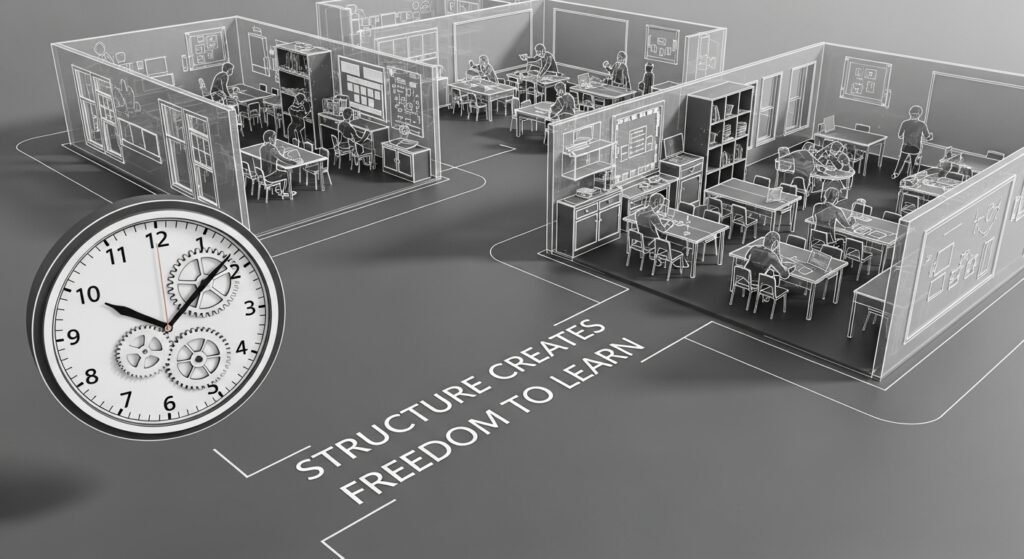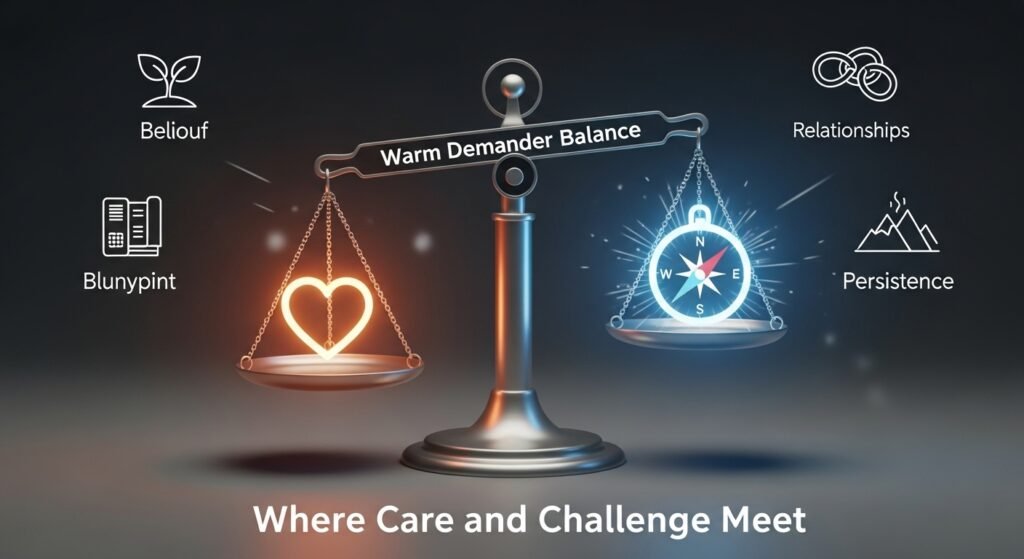Discover the 4 key traits of warm demander teachers who combine high expectations with genuine care to help every student thrive. Learn how to cultivate this empowering teaching style.
4 Characteristics of Outstanding Warm Demander Teachers
Think about the most influential teacher in your life. What made them so memorable? Chances are, it wasn’t just their command of subject matter or their perfectly organized lesson plans. It was something deeper—a unique blend of unwavering belief in your potential and the gentle but firm push to reach it. They likely embodied what educational researchers call warm demander teachers.
The concept of warm demander teachers originated in the 1970s through Judith Kleinfeld’s work with educators in Alaska, though the practice is as timeless as teaching itself. These educators master the delicate balance of radiating genuine care while maintaining non-negotiable high expectations. They are the teachers who look a struggling student in the eye and say, “I believe in you, and because of that, I won’t let you give up.”
In an era where educational approaches often swing between rigid authoritarianism and unstructured permissiveness, the warm demander pedagogy offers a powerful middle path. It’s a stance particularly effective for fostering resilience and achievement among students from marginalized backgrounds, as noted in Zaretta Hammond’s work on culturally responsive teaching. Research shows that students taught by warm demander teachers not only achieve academically but also develop stronger self-regulation and identity as learners.
So what exactly sets these educators apart? Here are the four defining characteristics of warm demander teachers.
Philosophical Inquiry in Preschool

1. Unwavering Belief in Every Student’s Potential
The Foundation:
Warm demander teachers operate from a fundamental conviction that every child is capable of excellence. This isn’t blind optimism—it’s an active commitment to seeing and nurturing the brilliance that others might overlook.
What It Looks Like in Practice:
- Asset-Based Language: They consistently use language that focuses on students’ strengths and capabilities rather than deficits. Instead of “This student can’t read well,” they say, “This student is developing reading skills and brings incredible storytelling ability.”
- Public Affirmation: They regularly and authentically celebrate student efforts and growth in front of peers.
- High-Expectation Actions: They assign complex tasks to all students, providing appropriate scaffolding rather than reducing challenge.
Why It Matters:
When students sense their teacher genuinely believes in them, they’re more likely to take academic risks and persist through difficulty. This characteristic forms the bedrock of the warm demander approach.

2. Consistent, Clear Boundaries and Structure
The Framework:
While warm demander teachers are nurturing, they are never permissive. They understand that clear expectations and predictable structures create the safety necessary for learning to thrive.
What It Looks Like in Practice:
- Explicit Routines: Classroom procedures are taught, practiced, and consistently reinforced.
- Predictable Responses: Students know how their teacher will respond to both positive choices and missteps—there are no emotional surprises.
- Academic Consistency: Assignments have clear criteria for success, and feedback is specific and timely.
Why It Matters:
Structure communicates care. It tells students, “This environment is so important that we’ve thoughtfully prepared every aspect to help you succeed.”
How Metacognitive Routines Build in Middle School ELA

3. Authentic Relationships and Cultural Responsiveness
The Connection:
Warm demander teachers invest deeply in knowing students as whole people—their interests, families, communities, and cultural backgrounds. This isn’t about being friends; it’s about demonstrating respect and connection.
What It Looks Like in Practice:
- Intentional Dialogue: They use conversations, surveys, and observations to learn about students’ lives outside school.
- Cultural Mirroring: They incorporate students’ cultural references, histories, and communication styles into teaching.
- Personalized Engagement: They notice and respond to individual students’ emotional states and needs.
Why It Matters:
Trust is the conduit through which high expectations can flow. Students will accept challenges from those they believe truly see and value them.
4. Insistence on Academic Persistence
The Push:
Perhaps the most defining trait of warm demander teachers is their refusal to accept less than a student’s best effort. They combine encouragement with an unyielding expectation that students engage with rigorous content.
What It Looks Like in Practice:
- Productive Struggle: They allow students to grapple with difficult concepts, resisting the urge to prematurely rescue them.
- Re-teaching and Retakes: They frame revision and re-teaching not as punishment but as indicators of a growth mindset.
- “Yet” Language: They consistently use phrases like “You haven’t mastered this yet” to emphasize the temporary nature of challenges.
Why It Matters:
This insistence communicates profound respect. It says, “You are capable of more than you think, and I won’t let you settle for less.”
Applied Scientific Thinking: A Practical Framework for Real-World Problem-Solving

The Warm Demander in Action: A Comparative View
| Characteristic | Traditional Teacher | Warm Demander Teacher |
|---|---|---|
| View of Student Potential | Fixed mindset; labels students | Growth mindset; sees potential |
| Classroom Management | Control-oriented; punitive | Structure-oriented; restorative |
| Student Relationships | Professional distance | Professionally intimate |
| Response to Struggle | Provides answer | Provides support and persistence |
Cultivating Your Warm Demander Stance
Becoming a warm demander teacher isn’t about mastering a technique—it’s about adopting a mindset. Here’s how to begin:
- Reflect on Your Beliefs: Examine your assumptions about student capability. Where might you be underestimating potential?
- Strengthen Your Structure: Develop predictable routines and clear academic expectations.
- Deepen Connections: Learn about your students’ cultures, interests, and strengths.
- Insist and Support: Pair high expectations with abundant support and encouragement.
Conclusion: The Power of Both/And
The magic of warm demander teachers lies in their rejection of false choices. They prove we don’t have to choose between being caring and having high expectations—in fact, each makes the other possible. They understand that true equity doesn’t mean lowering standards but providing unparalleled support to meet high standards.
As education continues to navigate challenges of equity and excellence, the warm demander approach offers a time-tested path forward. It reminds us that the most powerful teaching happens in the space between unwavering belief and unwavering expectation.
Which of these warm demander characteristics resonates most with your teaching philosophy? Share your experience in the comments below!
Best Time Management Apps for Students (2025) — A Practical Guide




Pingback: Teacher Retention Strategies and Solutions - PaidScripts -Tech Education Hub: Courses & Student Resources
Pingback: VR Ancient Civilizations Facts for Students - PaidScripts -Tech Education Hub: Courses & Student Resources
Pingback: Future of Work Skills for 2025 Employers - PaidScripts -Tech Education Hub: Courses & Student Resources